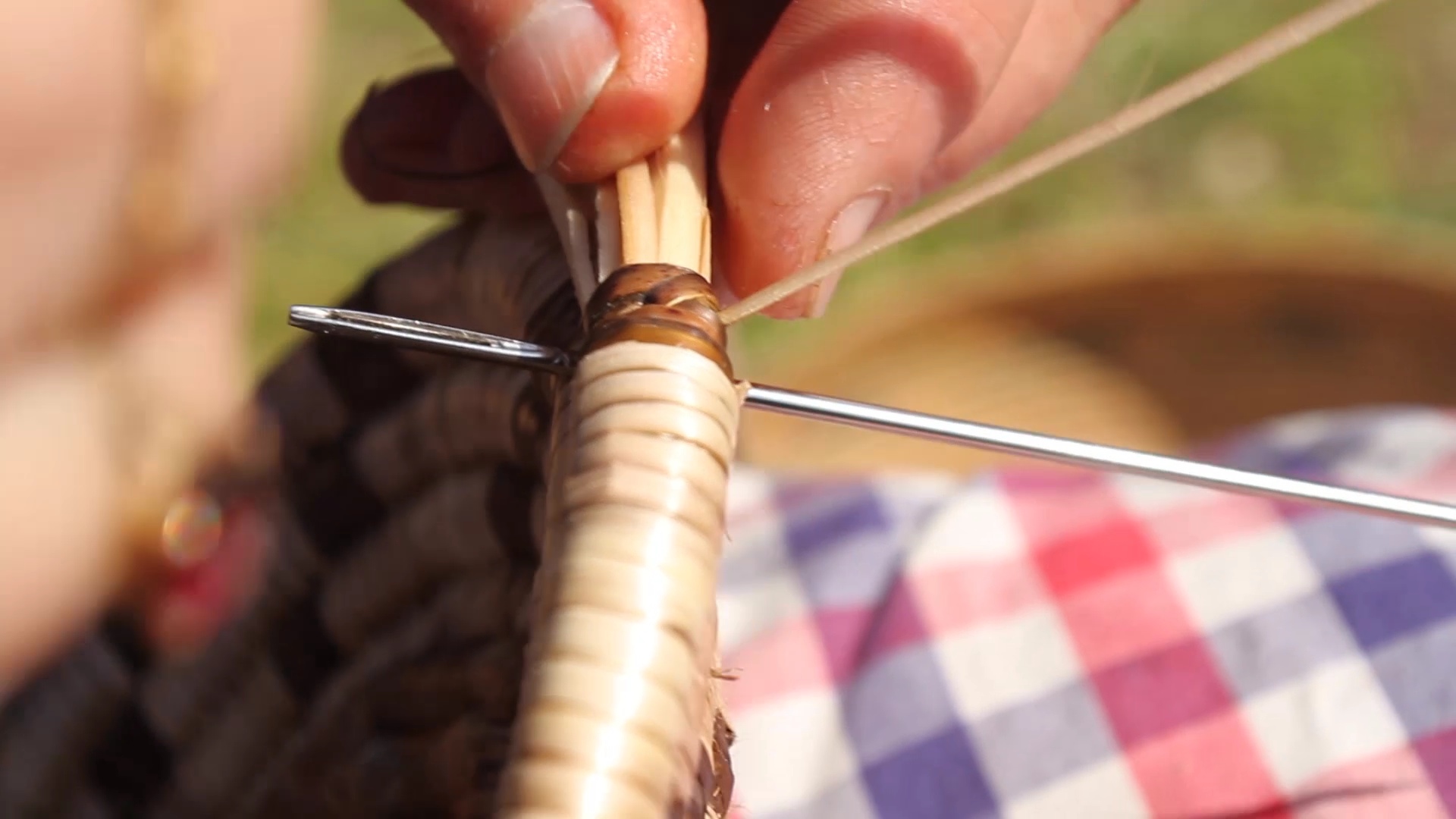
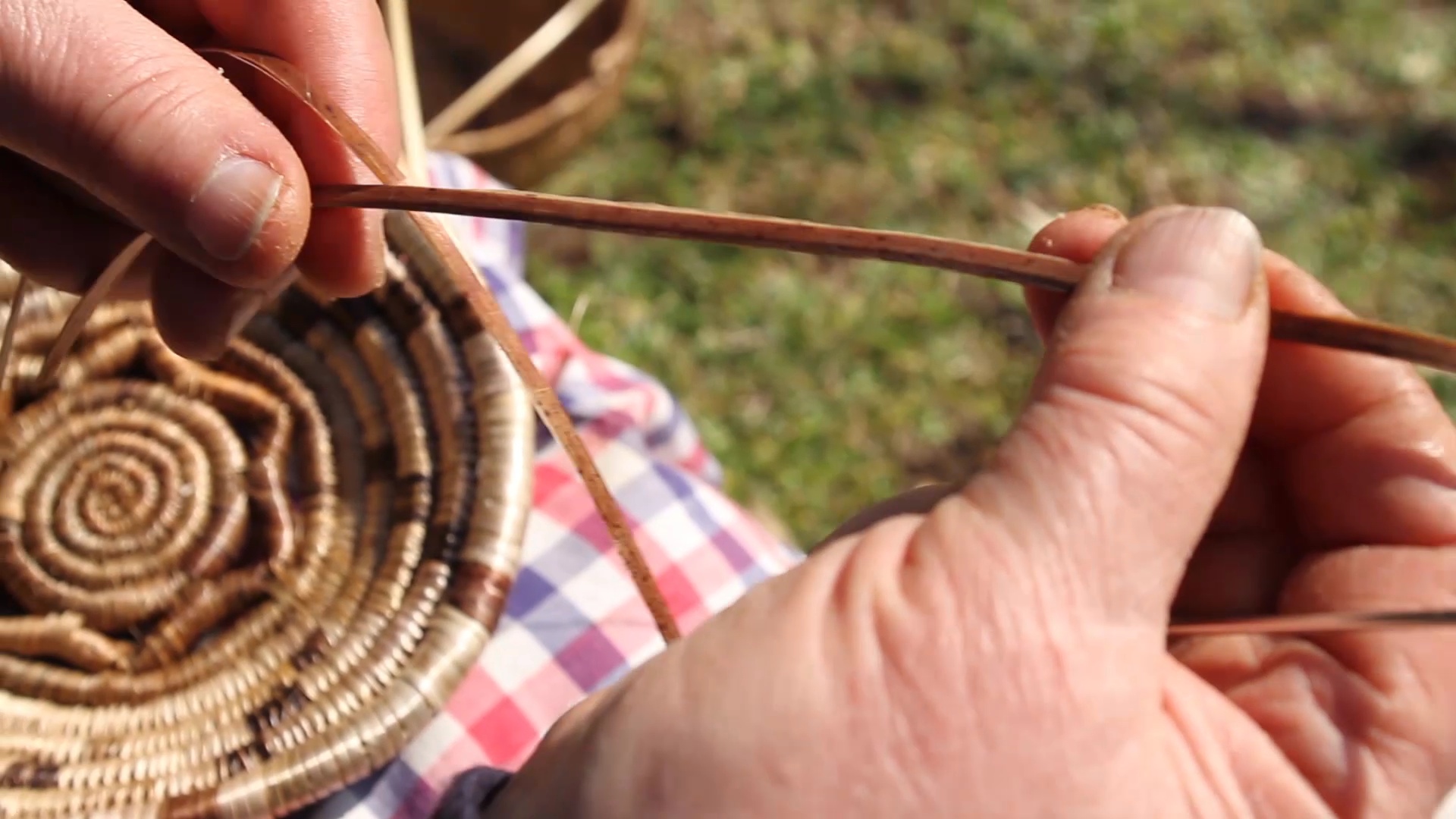
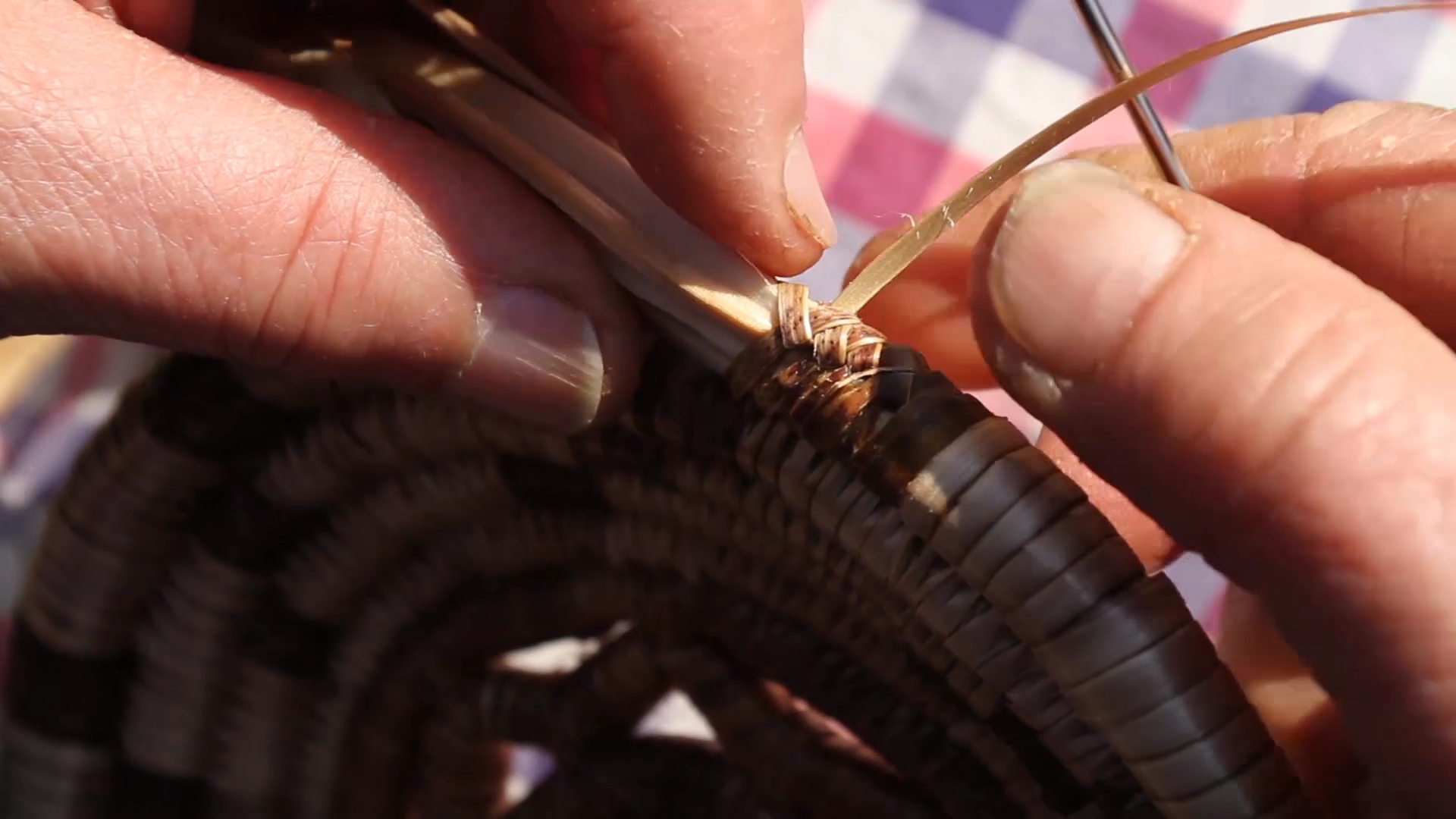
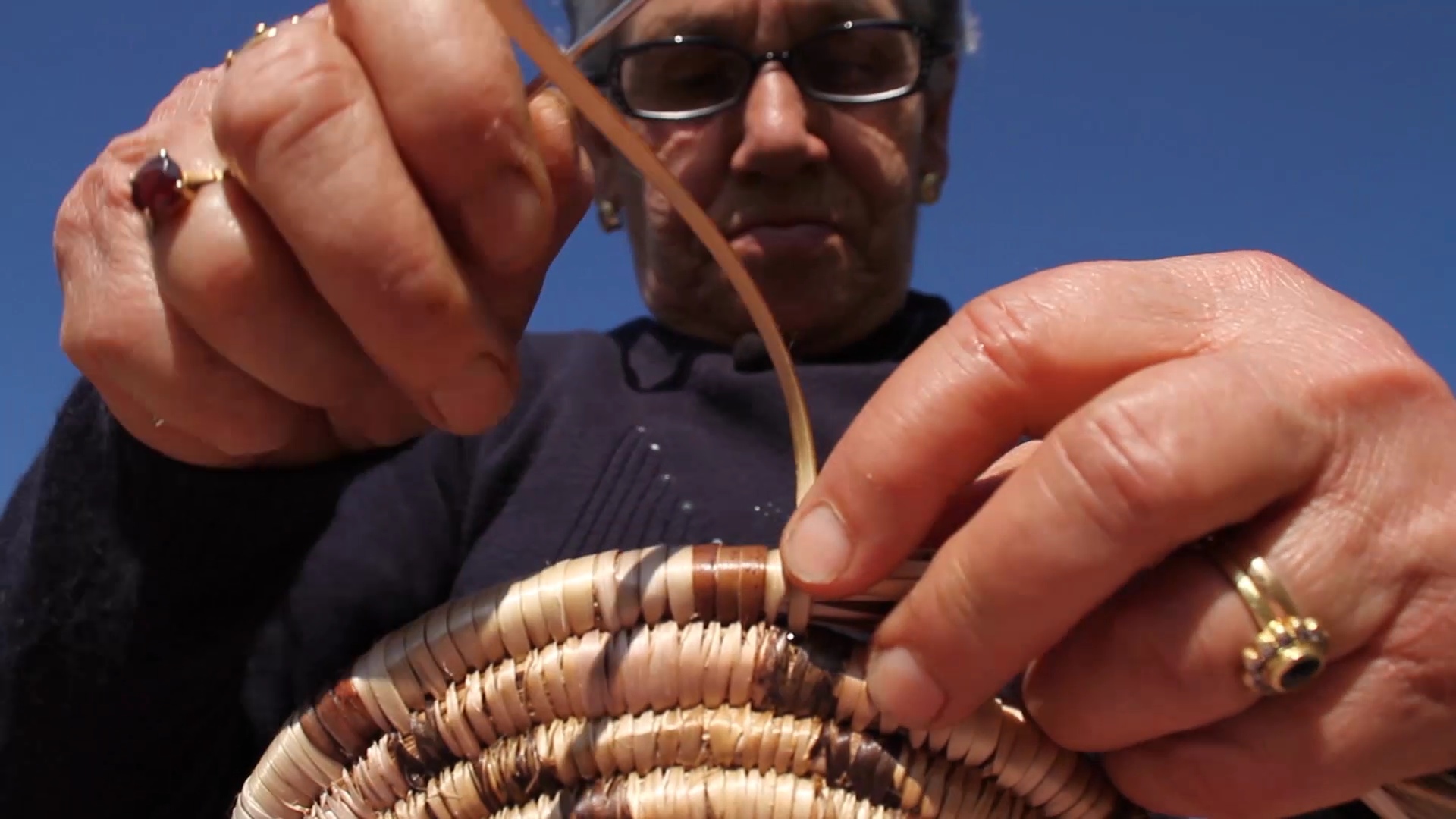
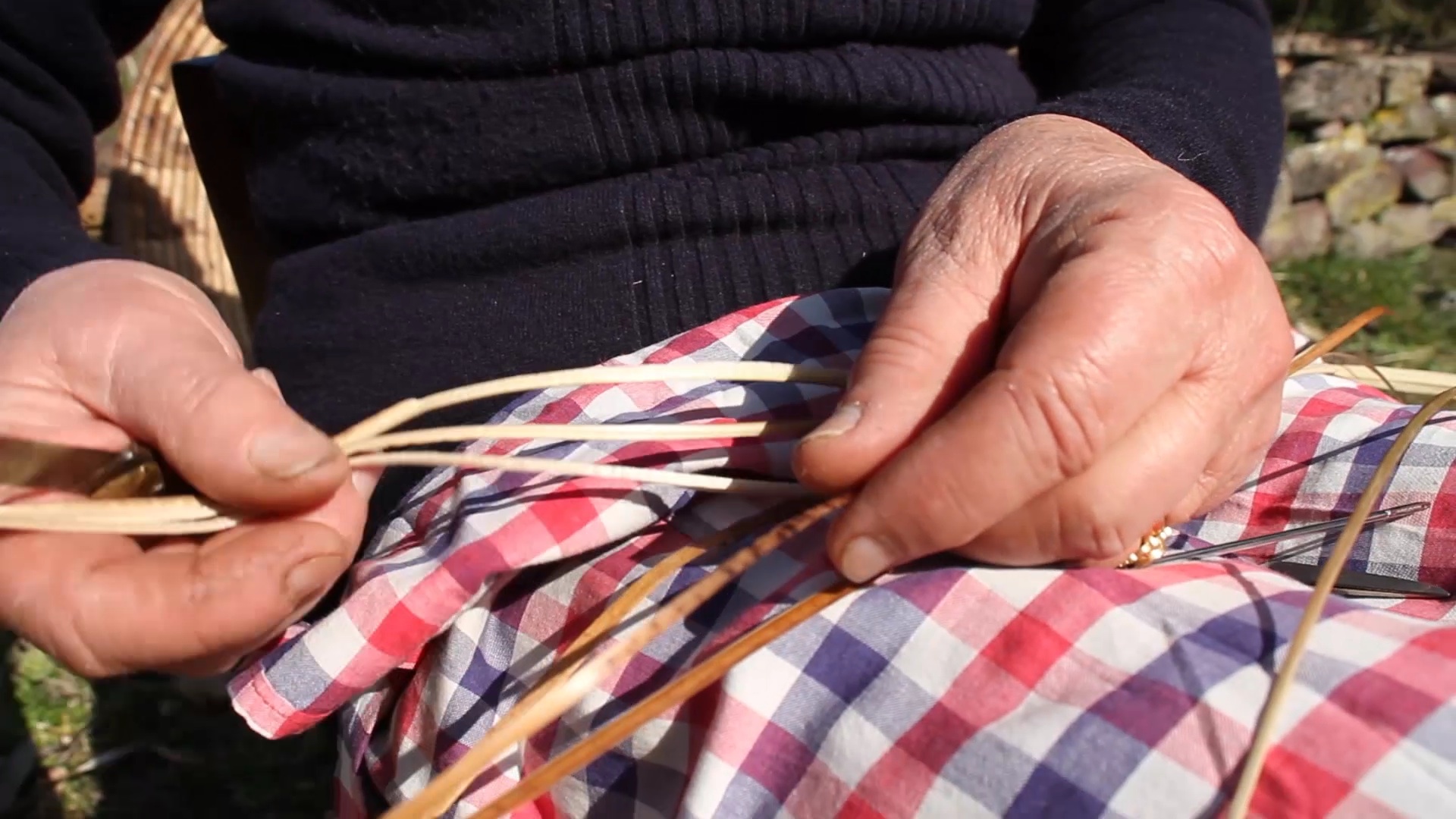
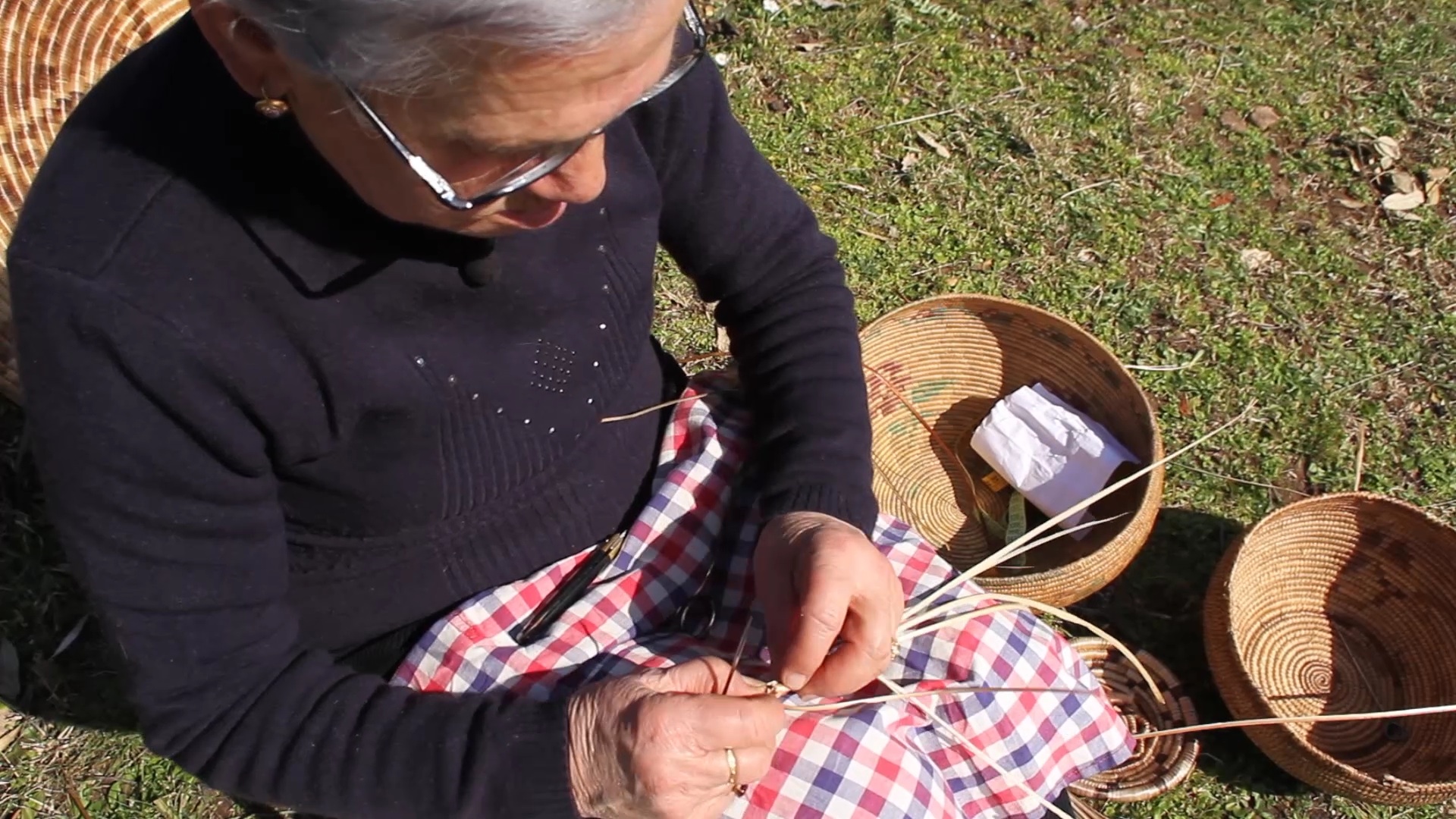
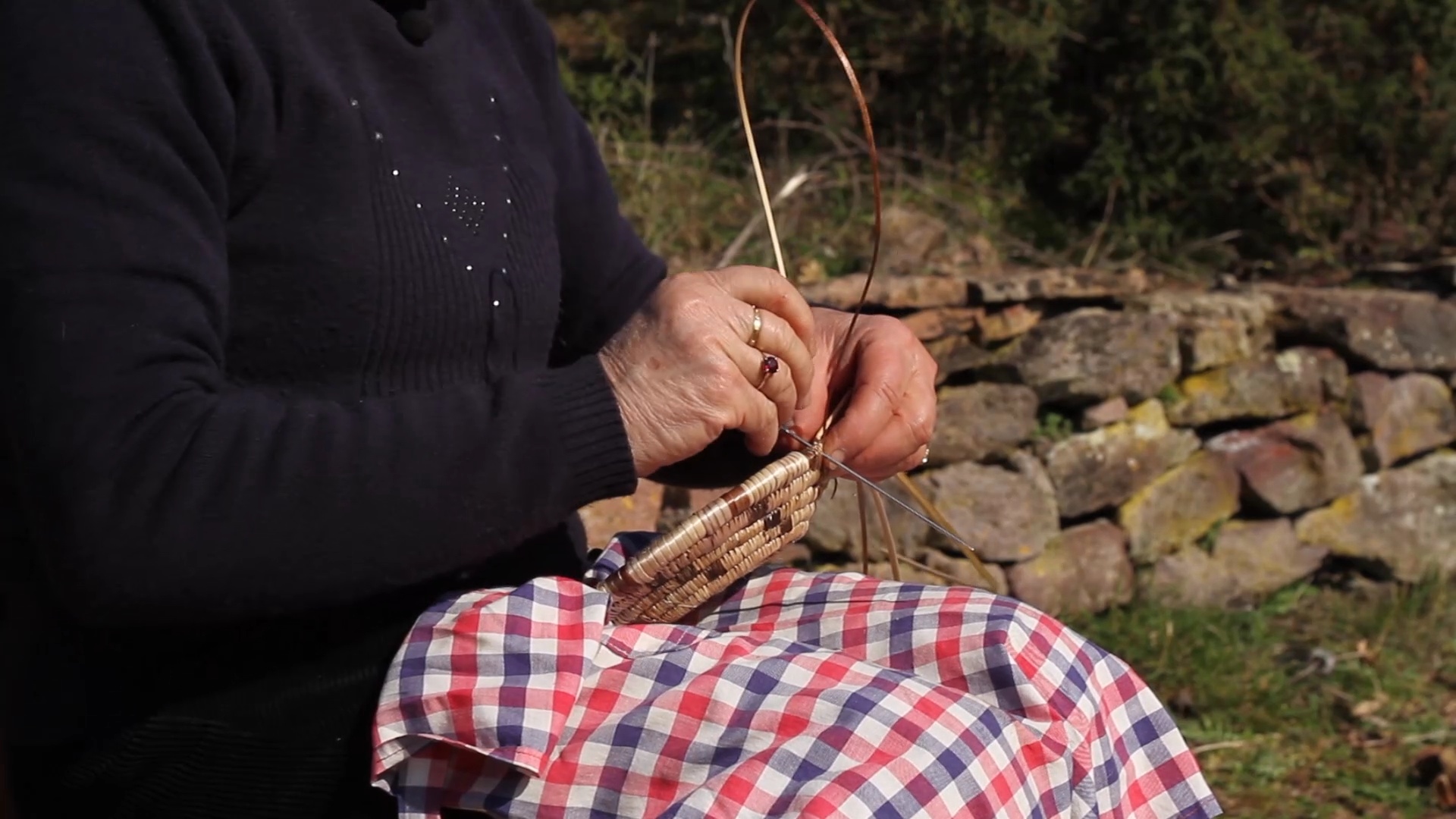
Based on the different arrangement of threads in the weave, in Sardinia two main categories of compositional techniques may be found: spiral structures and cross-shaped structures.
The list also includes types of weaving used for home and workplace linings and "artistic" products (palm weaving in Easter time).
The weaves of bread baskets and corbule (sets of baskets called "su strexiu de fenu" or "sa scraria", including three baskets and three corbule, all of which with inverted truncated conical shapes) follow the spiral pattern.
The spiral is made with a bundle of hard material that, with the aid of water and of a hook, is latched by spiral-shaped stitches wrapping the bundle of fibres, fixing it to the previous spiral.
Working on different coils, different shapes may be obtained.
The diversity of fibre materials characterizes these types of artefacts.
Baskets can be divided into:
- Warp made of culms of wheat and and weft made of reeds;
- Warp and weft made of asphodel;
- Warp made of stalks of wheat or sea hay and weft made of dwarf palm or raffia.
Other versions are characterized by different decorations.
Organic materials
Asphodel (Asphodelus microcarpus) is harvested just before the flowering, when the scape is still soft and supports the buds;
Durum wheat hay (Triticum durum - a variety referred to as "grano Kappelli"): its harvesting must be carried out manually when the wheat is ripe. The stem must be long between 30 and 40 cm;
Reeds ( Juncus acutus ): its harvesting starts between late April to early June, as soon as the inflorescence at the end of the culms, next to the spike, begins to ripen and dry out. The stems must be long between 130 and 150 cm.
In addition to the reed itself (in Sardinian, su zuncu de zinnigas), the stems of other varieties of marsh grasses are widely used: cyperus ( sessini or sèssene ), sedge ( zinnìga or sinnìga or sega didus, "taglia dita"), Mauritanian grass ( craccùriu or craccùli ), Giunchetto or clubrush ( zinnìga or tinniga ) and biòdolo or flowering rush ( o allu de aqua po istòias ).
Dwarf palm (Chamaerops humilis): harvested in spring and summer, usually during the hottest hours of the day, since the fibers make less resistance to cutting; imported rafia ( Raphia cuffia ).
Preliminary operations: preparing fibers
Preparing the reeds
After the harvest, fibres are dried in the sun. After a week, the culms of rush have a uniform greenish-yellow colour; they are then stored at room temperature in a dry place with little light. When each stem is used, it is divided by hand, alongs its length, with the aid of the knife or a prick punch, into 2-6 fibres (or threads) with a thickness of 0.5-2 mm. The fibres must be of the same length of the stem. They are the scraped with the aid of a knife blade, to get rid of the remains of the spongy medulla. At the end of this operation is over, the reed fibre looks very thin and flexible.
It is highly recommended to whiten it by exposing it to sulphur fumes for a maximum of 10 minutes. Or the entire artefact may be whitened by baking it in an oven. At the end of this operation the fibres should be light straw-yellow.
Preparation of durum wheat hay
Before processing them, the stalks of wheat should be stored at room temperature in a dry place with little light, making sure to remove the ear from the stalk, leaving only a small part of the spine where the inflorescence starts. When the hay ready, it is prepared by breaking the stem at the last node; by doing so the sheath that grew during the leaf development is also cleared. This operation is done manually with a slight pressure on the breaking points of the plant fibers at its nodes. The hay obtained must not contain any node; the usable part is the one between the last node and the ear.
Preparation of asphodel
After harvesting, the plants should be left in the sun to dry, generally gathered in bunches on the courtyard; in about twenty days, the stems lose most of their water and are ready for the following treatment. After this first dry-up phase, they are split vertically (with a knife tip), starting from the first half to the top of them, then from the middle to the root, and once divided, they are dried in the sun and covered at dusk, so that they are not affected by moisture. Then, the stems are gathered in large bundles ("sos mannugios") and stored in a dry place. Before starting weaving, the stalks must be hydrated in tanks for about 5 hours so that they become soft and flexible. After about a day, the bark is separated from the medulla; they are divided into 3 parts: "Sas Currias Nieddas", "Sas Currias Biancas" and "Sas Matas," which are, the outer, the middle and the inner stem, respectively. The first two, Sas Currias, are used to produce the patterns on the basket; they are wrapped and sewn around Sas matas.
Preparation of dwarf palm leaves
Before being used, dwarf palms are dried and then treated with special bleaching substances, in order to make its colour more uniform and neutral.
Starting processing
The starting point is a small spiral warp. Around it, the first fibres are intertwined, by fixing the wefts with a fixed stitch, at the beginning, with a double knot, one at the bottom and one on top. In this way, around the warp, two helical weft structures are latched with each other, making the complex weave compact. The end of the first spiral is where the starting point is reached again. From this point, each warp loop is tied to the previous through a thick sequence of stitches (top points).
When durum wheat is used, the first coil is made by gathering a bunch of fibers of raw reed, since hay can not bend into a certain curve. From a diameter of about 4 cm, reeds are replaced by hay. However, o single reed fibre is added to the warp to created a sturdier base structure.
How to add stitches
With the aid of a hook, a hole is drilled on the edge of the bundle of the lower warp; a string is drawn through it, securing the warp to the lower spiral and wrapping the current warp spiral. The distance between two stitches (shed) should be equal to the thickness of the wrapping fibre. To provide more strength, it is essential that the weft fibres are stretched and that the shed are not too far from each other. During the whole crafting, it is necessary to wet the fibres to increase their flexibility.
The following stitches can be used:
- Fixed stitch, i.e. at the end of each spiral a stitch is secured by means of a needle (point-to-point stitching);
- Twisted stitch or wide point stitch , if the stitch is secured after several spirals (a lazzus technique);
- chain stitch, that does not require a needle, but binds one loop to the other by wrapping the fibre to the previous loop. I
The finest, oldest and most enduring basked is the one featuring a fixed stitch.
Crafting the base
When the filling begins to run short, new fibres are added. They mustt be merged with the rest of the warp fibres, making sure that such connection is not visible. From the starting point, the warp and the weft are overlapped until the whole artefact is complete. The following steps are repeated.
Crafting the upper edges
The crafting of the vertical structure continues with the same technique. The different shapes and inclinations are obtained by latching the warp spirals more on the inside or the outside of the previous ones. Also the tilting of the punch must be adjusted accordingly.
Crafting the decorations
The baskets made of reeds and in cane and wheat straw may also feature clippings of coloured fabric between the weft and warp fibres. The initial part of the weave, at the base of the container, can be decorated with a small circle of damask cloth, latched by the stitches. On the upper edges, at a distance of twenty centimetres from one another, coloured bows may be added to recall bunches of butterflies. The decorations can be also made by using coloured reeds. These reeds are boiled with dyes obtained from various plants (walnut, pomegranate, madder).
Satin trimmings may be added to inner walls, lids, small oval corbule and vessels. In the asphodel baskets, decorations are made by combining different shades of colour on the outer and central sections of the stem. The decorative motifs are made by combining the different shades of brown of the weft fibre, the background being usually of a lighter shade.
In the baskets made of raffia or dwarf palm fibres, colours are chosen during the preparation phase, by the different exposure to the sun or by boiling the fibres together with mastic ash. Decorative motifs feature stylized animal figures and floral motifs which are traditionally used also in other Sardinian handicrafts, usually including birds, rosettes, stars, leaves, crenellations and frames.
Decorations are made with the Greek fret technique, that is, a series of identical and queueing motifs: motifs must show no break at any point of the loop.
Finishes
Once the artefact is crafted, it must also be finished. The fibres and the fabric in excess must be removed with the aid of scissors or burnt on paper or straw flame, keeping the baskets at a certain distance to avoid burnishing. At the base of the product a small stand (a base or a step) can be added, with a height between 1 and 3 cm, and a diameter equal to the base. The step must be made with the same technique as the rest of the basket and may be decorated with taffeta strings.
Tools used
The “Intreccio artigiano - Sardegna” techniques re use of the following tools:
- an iron or bone punch or hook (su puntarolu, su raju, sa sua), a T-shaped tool consisting of a wooden handle and a steel needle embedded in the handle, or only made of metal. The needle is 2 mm thick and has a maximum length of 10. It is used to drill holes through which fibres are drawn, making up the weave.
- small scissors (is ferrixeddus), equipped with blades of about 2 cm, used to refine the warp fibres and the fabric scraps in excess;
- knife (s'arresoia) with a well sharpened tip, used to remove unnecessary parts from the fibres or the bark from the medullary portion of the plant; - container and/or tank, to keep the water used to wet the fibres during crafting
(Disciplinare di Produzione Intreccio artigiano - Regione Autonoma della Sardegna)

